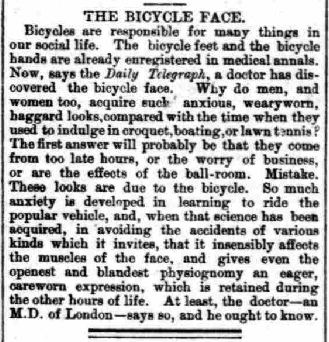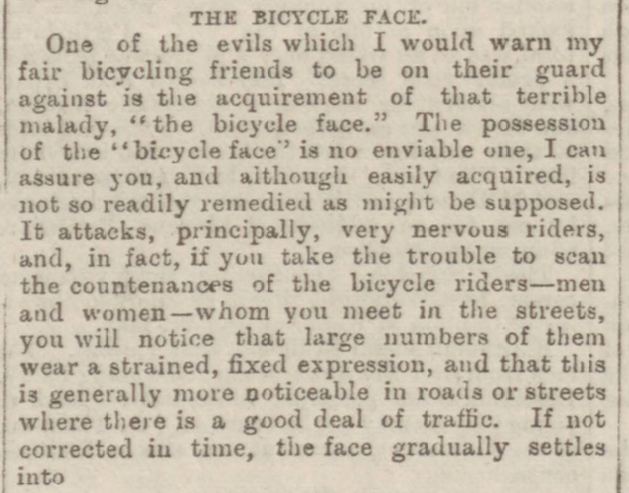Genes Reunited Blog
Welcome to the new Genes Reunited blog!
- We regularly add blogs covering a variety of topics. You can add your own comments at the bottom.
- The Genes Reunited Team will be writing blogs and keeping you up to date with changes happening on the site.
- In the future we hope to have guest bloggers that will be able to give you tips and advice as to how to trace your family history.
- The blogs will have various privacy settings, so that you can choose who you share your blog with.
Official Blogs
Has the Tour De France got you in the mood for a bike ride?
Has the Tour De France got you in the mood for a bike ride? Be careful not to catch the dreaded ‘Bicycle Face’.
As the world’s top cyclists are enduring the first stages of the 2014 Tour De France, thousands of cycling enthusiasts from all parts of the country will be donning their Lycra and taking to Britain’s roads and cycle paths. With so many people catching the ‘cycling bug’ this time of year, we decided to take a look at Genes Reunited’s collection of historic newspapers to see what cycling-related stories we could unearth. What we discovered were reports of a mysterious and terrible illness that posed. a great threat to any Victorian women brave enough to take to the saddle, the dreaded ‘Bicycle Face’.

- Cheltenham Chronicle, Sat 22 August 1896
Bicycle face was actually a fictitious disease invented by the medical establishment of the 19th century, used predominately to discourage women from cycling. The invention of the bicycle revolutionised the day-to-day lives of many women and proved to be a significant milestone on the road towards freedom and equality.
Bicycles gave women a new-found independence that had not been enjoyed by previous generations. It provided them with the ability to travel outside their homes on their own accord and a freedom of movement that allowed them to gain roles of increased influence in society. In fact, the bicycle has been cited by some historians as one of the single greatest tools of female emancipation. This in turn led to changes in attire for women who began to choose less formal and restrictive clothing that allowed them to ride their bicycles with greater ease. These new developments were a cause of great excitement for many, yet for others they were a cause for great concern.
Many physicians during this period held that women’s bodies simply weren’t suited to cycling. They wrote in medical journals that the continued strain of keeping a bicycle balanced while riding would cause women to suffer from permanently contorted faces. They named the disease ‘bicycle face’, the symptoms of which included bulging of the eyes and tightening of the jaw.

- Evening Telegraph, Monday 24 May 1897
It appears that these symptoms were carefully construed to directly contrast the soft and fine features that were widely considered beautiful at the time. According to the physicians and many critics, developing an unsightly face was not the only danger women cyclists faced. They claimed other more serious maladies could also be caused by the strain of riding a bike, ranging from consumption to an increased libido, sexual perversion caused by motion of the bike and the proximity of the seat to women’s genitals and infertility caused by the shaking the womb while riding over rough surfaces.
One physician in particular, a Dr A. Shadwell, was a staunch critic of women on bikes. In 1897, he published a highly controversial article in the National Review London titled ‘The hidden dangers of cycling’. It outlined the wide range of medical problems in great detail which, according to Shadwell, included internal inflammation, exhaustion, bicycle face, appendicitis, dysentery and nervous attacks.
Shadwell’s assessment was widely criticised and contested by cycling enthusiasts, both male and female. They argued that the physical benefits far outweighed any imagined ailments the activity may cause and that the activity was fantastic way to improve one's health and vitality.
Opposition to cycling on medical grounds began to disappear in the 1890s as the activity was embraced by the upper class. The popular book ‘Women's Sports Medicine and Rehabilitation’ cited bicycle face as an example of failures by medical doctors to understand and treat women appropriately and responsibly.
Examining the Genes Reunited collection of historic newspapers is a fantastic way to gain a better understanding of the world your ancestors lived in. They can reveal remarkable details about the attitudes and ideas of time, many of which seem very odd today. With this year’s Tour De France seeing women race alongside men at a one day stage on the Champs-Elyseés, it’s a relief to see that most of these bizarre beliefs have long since been dismissed.

- Evening Telegraph, Tuesday 23 February 1897
Comments
|
Send Message |
What a laff!!!!
|
|
Send Message |
It's laughable now when we read that drivel that some GP cooked up back then to stop women from riding bicycles - but disturbing to think they could get away with it as well.
|
|
Send Message |
Once upon a time a youthful male took to cycling something akin to the fish to water fashion. The original sit up & beg model of a cycle was quickly discarded for a lighter weight made to measure frame made from "Reynolds 531 tubing" with cut out lug work. The down tube being ten inches less than the inside of the leg length.
(33 inches inside leg = a 23 inch frame) (The down tube has the saddle inserted ) A derailleur three speed gear, sufficient for use on any road incline which if too steep to cycle up while sat on the saddle indicated a short walk. Why honk ? Mudguards covered both wheels. Prevented wet weather mud splash. 28 inch diameter wheels instead of the normal 26inch with one inch width wheel rim of lightweight steel all assisted fatigue reduced effort. Ladies too joined in the pastime and not one of them had that despicable so termed, "Bicycle Face". Happy days Who required a Tour de France to create the mood? :-) :-) :-) |

